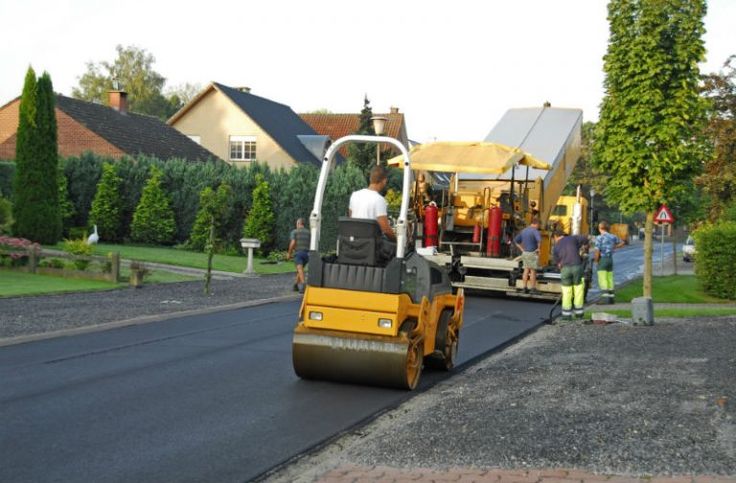Introduction
Paving solutions are a critical investment for commercial properties. Whether you’re working with parking lots, driveways, or sidewalks, ensuring their endurance is critical for both aesthetic and safety reasons. But what factors influence the lifespan of commercial paving solutions? In this post, we’ll look at the important aspects that influence the lifespan of various paving materials, how they function in different settings, and how to increase their durability.
Types of Commercial Paving Solutions
Commercial properties can choose from a variety of paving materials, each with advantages and disadvantages. The material used to create a surface determines its lifespan.
Asphalt
Asphalt is one of the most used materials for commercial pavement. It is known for its flexibility and ease of installation, as well as its smooth finish, which can last up to 20-30 years with good maintenance.
Concrete
Concrete is a highly durable material that can withstand intense traffic for extended durations. With a lifespan of 30-50 years, it is more expensive than asphalt but is generally justified by lower maintenance costs.
Pavers
Pavers provide a versatile and aesthetically pleasing choice for commercial properties. They are resilient, easy to repair, and allow for innovative designs, albeit their lifespan varies depending on the material used.
Other Materials
Other materials, such as gravel or permeable pavements, are occasionally employed, particularly for houses looking for environmentally responsible solutions. These solutions are often less expensive, but may not be as durable as asphalt or concrete.
Key Factors That Affect the Durability of Paving Solutions
Material Selection
Choosing the correct material is critical. Strength and flexibility are important considerations in determining how a surface will perform under pressure. Asphalt and other materials that may expand and contract in response to temperature variations are less prone to cracking.
Climate and Weather Conditions
The weather has a considerable impact on the lifespan of commercial pavement.
Temperature Extremes
Both asphalt and concrete can disintegrate in high temperatures. High temperatures can cause asphalt to weaken and fracture, while freezing conditions can cause water to expand in the pavement, resulting in potholes.
Rain, Snow, and Ice
Excessive water can deteriorate pavement materials if sufficient drainage is not installed. Snow and ice can also inflict significant damage if allowed to melt and refreeze, resulting in cracks and holes.
Traffic Loads and Usage
The amount of traffic on a paved surface has a significant impact on its lifetime.
Heavy-Duty vs. Light Traffic
Heavy vehicles, such as delivery trucks, put far greater pressure on a pavement than standard passenger automobiles. Areas with significant traffic require materials with strong load-bearing capacity.
Vehicle and Foot Traffic Impact
High amounts of foot activity can also wear out surfaces, particularly paver materials that may shift with time.
Installation Quality
Poor installation can lead to early failure, regardless of the quality of the material.
Importance of a Proper Base
The foundation is crucial. Even the best pavement material will degrade over time if not installed on a properly compacted base.
Correct Layering Techniques
To avoid concerns like water penetration and movement, materials must be properly layered.
Maintenance Practices
Regular upkeep is essential for extending the life of commercial paving.
Regular Sealing and Repairs
Regular sealing can help protect asphalt surfaces from water, UV rays, and chemicals. Cracks that are repaired early on are less likely to worsen into larger problems.
Cleaning and Debris Removal
Debris-like dirt and leaves can trap moisture on the surface, causing it to wear out faster. Regular cleaning is required to keep the pavement in good condition.
The Role of Drainage in Paving Longevity
Paved surfaces are more vulnerable to water damage. A robust drainage system is critical to increasing the life of any commercial pavement solution.
Proper Drainage Systems
Water can pool on the surface, causing erosion and cracking, therefore properly sloping surfaces and enough drainage channels assist prevent this.
Issues from Poor Drainage
Without appropriate drainage, even the best-installed paving will fail over time as water seeps into the foundation, causing it to shift or deteriorate.
Soil Conditions and Their Impact on Paving Lifespan
The stability of the earth underlying the pavement is critical to its long-term function.
Soil Type and Stability
Some soil types expand and compress more than others, which might cause instability when paving.
Soil Preparation Techniques
Proper soil compaction before installation can help to minimize potential ground movement difficulties.
Paving Design Considerations
The design of the paving, including thickness, slopes, and elevations, influences how well it manages traffic and weather conditions.
Thickness and Layering
The pavement should be thick enough to withstand the estimated traffic load. Thicker pavement typically lasts longer.
Slopes and Elevations
Correctly built slopes promote proper water drainage and limit the likelihood of water pooling.
Environmental Factors
UV Radiation and Sunlight Exposure
UV rays from the sun can degrade materials such as asphalt over time, causing them to fade and become brittle.
Impact of Chemicals and Pollutants
Chemicals included in car fluids, deicing salts, and industrial contaminants can degrade the surface, reducing its longevity.
Technological Advancements in Paving Materials
New Innovations for Durability
Advances in paving technology, such as polymer-modified asphalt, have resulted in materials that are more weather and traffic-resistant.
Sustainable Paving Solutions
Sustainable materials, such as permeable paving, allow water to pass through, decreasing runoff and environmental impact.
Common Mistakes that Reduce Paving Lifespan
Poor Material Choices
Using low-quality materials or those that are not climate-appropriate can dramatically shorten the life of commercial pavement.
Lack of Maintenance
Failure to undertake regular maintenance, such as sealing and cleaning, speeds up the wear and tear process.
How to Prolong the Life of Commercial Paving
Best Practices for Maintenance
Regular sealing, cleaning, and crack repair can significantly increase the life of commercial paving.
Preventive Measures for Longevity
Consider using high-quality materials, ensuring appropriate installation, and resolving drainage concerns early on to avoid future complications.
Signs Your Paving Needs Repair or Replacement
Visible Cracks and Potholes
When cracks and potholes occur, it’s crucial to plan repairs before the damage escalates.
Fading and Discoloration
Fading is often indicative of UV damage or the need for resealing.
Cost-Effectiveness of High-Quality Paving
Long-Term Saving
Investing in high-quality materials and competent installation might result in long-term cost savings by avoiding regular repairs.
Avoiding Frequent Repairs
Low-cost pavement options may appear to be a good deal at first, but they frequently result in pricey repairs later on.
Case Studies: Successful Long-Lasting Paving Projects
Real-world examples demonstrate that commercial properties can benefit from investing in high-quality materials and regular upkeep.
Conclusion
In conclusion, the longevity of commercial paving solutions is determined by a variety of criteria such as material selection, climate, traffic, and maintenance. Property owners can extend the life of their paved surfaces by choosing the right material and design, guaranteeing proper installation, and performing regular maintenance.




